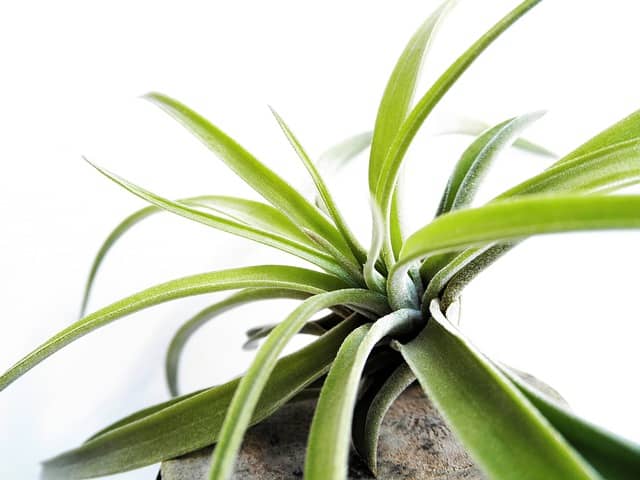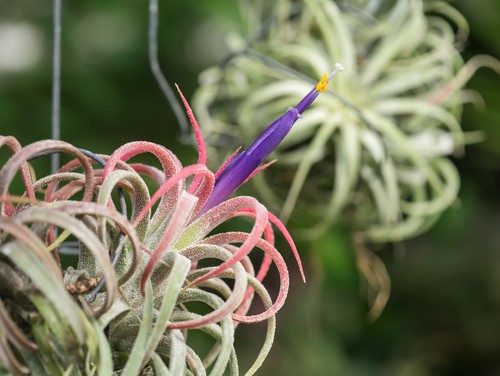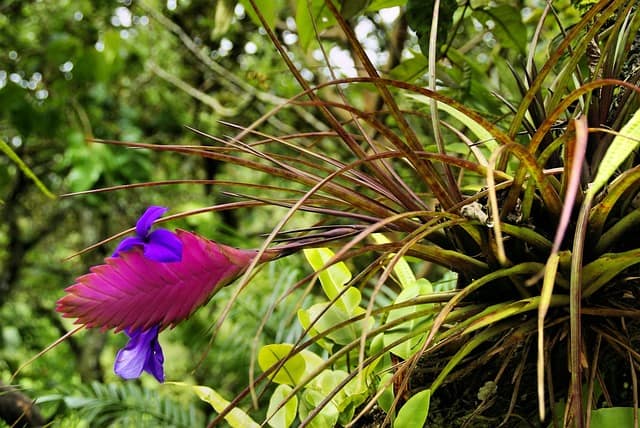Air plants, also known as tillandsia, are a popular choice for indoor gardening because of their unique appearance and low maintenance needs. One question that often arises among air plant enthusiasts is whether air plants bloom more than once. The answer is no, air plants only bloom once in their lifetime.
Understanding the blooming process of air plants can help explain why they only bloom once. Air plants bloom to reproduce, and the flowers on the plant are its reproductive organs.
Once the plant has bloomed and reproduced, the mother plant will die. This means that air plants have a finite lifespan, and they will only bloom once before beginning the process of producing new pups.
Key Takeaways
- Air plants only bloom once in their lifetime.
- The blooming process of air plants is tied to their life cycle and reproductive needs.
- Proper care and environmental factors can impact the blooming of air plants.
Learn more about plant care from these other posrs:
- Can You Water Plants with Pool Water?
- Can You Use Ortho Home Defense on Plants?
- Can You Use Cactus Soil for Regular Plants?
Understanding Air Plant Blooms

Air Plant Species and Their Blooms
Air plants are unique and fascinating plants that are known for their ability to grow without soil. They come in different shapes, sizes, and colors, and each species has its own unique blooming process. Some air plants will bloom only once in their lifetime, while others may bloom multiple times.
The Tillandsia xerographica, for example, is a popular air plant species that produces purple or red flowers. On the other hand, the Tillandsia harrisii has orange to red flowers. The color of the flowers depends on the species of the air plant.
How Often Do Air Plants Bloom?
Air plants are known for their beautiful and unique blooms, but how often do they bloom? Most air plants will bloom only once in their lifetime, producing one or more flowers. It takes a plant between one and two years to flower, and the bloom can last for a few weeks to a month.
After blooming, the air plant will begin to produce offsets or “pups,” which are the plant’s offspring. The number of offsets produced depends on the species of the air plant. Some species will produce only one offset, while others may produce up to three.
It is important to note that not all air plants will bloom, and some species may take longer to bloom than others. The blooming process is also affected by environmental factors such as light, temperature, and humidity.
Life Cycle of Air Plants
Air plants, also known as Tillandsia, are unique and fascinating plants that are known for their ability to grow without soil. These plants have a unique life cycle that includes different stages of growth, blooming, and propagation.
1. From Seed to Bloom
Air plants start their life cycle as tiny seeds that can take several weeks to germinate. Once they start to grow, they will slowly develop into adult plants. It can take several years for an air plant to reach maturity and start to bloom. The blooming process is triggered by the plant’s growth cycle, and it is a sign that the plant has reached maturity.
It’s important to note that air plants only bloom once in their lifetime. The blooming process can last anywhere from a few days to several weeks, depending on the species. During this time, the plant will produce a beautiful flower that can range in color from vibrant pinks and purples to soft whites and yellows.
2. Post-Bloom: Pups and Propagation

After an air plant has bloomed, it will start to produce offsets, also known as “pups.” These pups are small plants that grow at the base of the parent plant. The parent plant will eventually die off, but the pups will continue to grow and mature into adult plants.
Air plants can also be propagated through division. This involves carefully separating the pups from the parent plant and allowing them to grow on their own. Once the pups have reached maturity, they will start to produce their own offsets, continuing the cycle of growth and blooming.
Air Plant Care for Blooming
Air plants are known for their unique ability to bloom, and many plant enthusiasts wonder if they bloom more than once. The answer is yes, air plants can bloom multiple times in their lifetime with proper care. In this section, we will discuss the care required to encourage air plants to bloom multiple times.
1. Light Requirements
Air plants require bright, indirect light to thrive. Direct sunlight can damage the leaves and cause them to dry out. However, they do need some exposure to sunlight to bloom.
To ensure that your air plants receive enough light, place them near a window that receives bright, indirect light. If you notice that the leaves are turning brown or curling, it may be a sign that they are getting too much sunlight.
2. Watering and Humidity
Proper watering is essential for air plants to bloom. They absorb water through their leaves, so it is important to soak them in water for at least an hour once a week.
After soaking, allow them to dry completely before putting them back in their display. In addition to soaking, misting the leaves with water once a week can help maintain the humidity levels that air plants require to thrive.
3. Fertilizing for Blooms
Fertilizing your air plants can help encourage blooming. Use a low-nitrogen fertilizer or a bromeliad plant food once a month during the growing season. Be sure to follow the instructions on the package carefully to avoid over-fertilizing, which can damage the plant.
Environmental Factors Affecting Blooming

Air plants are unique in that they do not require soil to grow. Instead, they absorb nutrients and moisture from the air through their leaves. This makes them ideal for indoor decoration, as they can be placed in a variety of containers and creative arrangements.
One of the most exciting aspects of air plants is their blooming cycle. While not all air plants bloom, many do, and their flowers can be quite stunning. But what factors influence whether or not an air plant will bloom, and can they bloom more than once?
Natural Habitats of Air Plants
To understand the environmental factors that affect blooming, it is helpful to look at the natural habitats of air plants. Air plants are found in a variety of climates, from tropical rainforests to arid deserts.
However, most species of air plants are native to regions with high humidity levels and moderate temperatures. They are often found growing on trees, rocks, or other structures where they can absorb moisture from the air.
Indoor Conditions for Blooming
When it comes to indoor conditions for blooming, there are several factors to consider. The following table summarizes some of the key environmental factors that can affect blooming:
| Environmental Factor | Effect on Blooming |
| Climate | Moderate temperatures and high humidity levels are ideal. |
| Rainfall | Air plants do not require regular watering, but misting or soaking can help encourage blooming. |
| Wind | Air plants prefer still air, as strong winds can damage their delicate leaves. |
| Humid Environments | High humidity levels can help air plants absorb moisture and nutrients from the air. |
| Direct Sunlight | While air plants need some light to grow, direct sunlight can be too intense and lead to leaf burn. |
| Indirect Light | Air plants prefer bright, indirect light for optimal growth and blooming. |
In general, air plants are relatively low-maintenance and can thrive in a variety of indoor environments. However, if you want to encourage blooming, it is important to provide the right conditions. This may include misting or soaking your air plants regularly, providing bright but indirect light, and avoiding direct sunlight and strong winds.
Common Questions About Air Plant Blooming
Air plants, also known as Tillandsias, are fascinating plants that grow without soil and can be a great addition to any indoor garden. One of the most exciting things about air plants is their blooming process. Here are some common questions about air plant blooming:
1. Do Air Plants Bloom More Than Once?
Air plants bloom only once in their lifetime, which can last from a few weeks to a month. After blooming, the plant will begin to produce new pups, which can be separated to create new individual plants. However, it is possible for some air plants to produce more than one bloom during their lifetime, although this is relatively rare.
2. What Color Flowers Do Air Plants Have?
The color of an air plant’s flowers can vary depending on the species. Some air plants have red flowers, while others have white, pink, or purple flowers.
For example, the Tillandsia xerographica has purple or red flowers, while the Tillandsia harrisii has orange to red flowers. Some air plants also have fragrant flowers, which can add a pleasant scent to your indoor garden.
3. How Can You Encourage Air Plants to Bloom?

To encourage air plants to bloom, it is important to provide them with the right conditions. Air plants need bright, indirect light and good air circulation to thrive. They also need to be watered regularly, but not too much.
Overwatering can cause the plant to rot and prevent it from blooming. Fertilizing air plants with a low-nitrogen, water-soluble fertilizer can also help promote blooming.
4. Can Air Plants Have Multiple Blooms?
While air plants usually only bloom once, some species can produce more than one bloom during their lifetime. For example, the Tillandsia aeranthos can produce multiple blooms in a single season. However, this is relatively rare and depends on the species and growing conditions.
Frequently Asked Questions
How long do air plant flowers last?
Air plant flowers typically last for a few weeks to a month before they dry up and fall off. The exact duration of the bloom depends on the species of air plant and environmental factors such as temperature and humidity.
What happens to an air plant after it blooms?
After an air plant blooms, it begins to produce new pups or offsets. These pups will eventually grow into mature plants and may also bloom when they reach maturity.
How long do air plants live after blooming?
Air plants can live for several years after blooming, but their lifespan depends on various factors such as their species, growing conditions, and care. With proper care, air plants can live for several years and produce multiple blooms throughout their lifetime.
Should you deadhead air plants?
No, you do not need to deadhead air plants after they bloom. Instead, allow the flowers to dry up and fall off naturally. This process signals the plant to start producing new pups or offsets.
How often do air plants produce pups?
Air plants produce pups at different rates depending on their species and growing conditions. Some air plants produce pups more frequently than others. On average, air plants produce one to two pups per year.
Do air plants only bloom once?
Yes, air plants typically bloom only once in their lifetime. The bloom usually occurs after the plant reaches maturity, which can take one to two years. However, some species of air plants may bloom more than once in their lifetime.

Hey, I’m Lisa and I’ve been an avid gardener for over 30 years. I love writing, talking and living in the garden! Feel free to connect with me on my socials below


